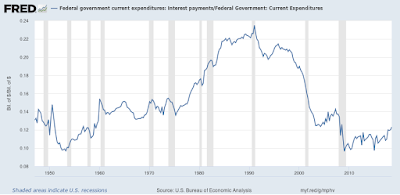Financialization is a fuzzy concept. There are many definitions, and none is clear cut, at least to characterize the changes of the last 40 years or so, which is the period most authors associate with financialization. I'm not suggesting it's not a useful concept though.* In some sense, financialization refers to the last phase in the capitalist system (even if there are ways in which one might argue that capitalism was always financialized). At any rate, going to the point I wanted to make, the financial burden of public debt went down in the 2000s, but that is not necessarily a good sign. I was trying to check the financial burden of public debt (i.e. the total spending on interests, out of total current spending) in the United States. The figure above shows that the
Topics:
Matias Vernengo considers the following as important: American Hegemony, Debt, financialization, Gerald Epstein, Palley, Secular stagnation
This could be interesting, too:
Joel Eissenberg writes The end of the “American Century”
Matias Vernengo writes Paul Davidson (1930-2024) and Post Keynesian Economics
Matias Vernengo writes The Economist and the American Economy
Robert Skidelsky writes Britain’s Illusory Fiscal Black Hole

The hike in interest rates in the late 1970s increased the financial burden of public debt, and with the lower output growth -- associated not just to higher interest rates and its effects on consumption, but also higher unemployment and lower wages which additionally impacted private demand -- debt dynamics was on the unstable side of the Domar rule (r > g) and public debt increased significantly in a peaceful period that was for the most part prosperous.
Public debt normally increased in periods of crises or of external threats (wars). In other words, public debt was an instrument for the preservation of society for the most part. There was also an agreement that public debt was a necessary instrument for the accumulation of capital, and it provided a secure asset for the functioning of the financial system. Btw, that was a point that was contentious, and not everybody accepted the Hamiltonian notion that public debt could be, to some degree, a blessing. Think of Andrew Jackson's payment of debt, and the various modern Cassandras afraid about the debt burden on future generations.
The rise of public debt since the 1980s (with the minor decrease in the late 90s) has served a very different purpose. While part of it can be seen as the reaffirmation of American Hegemony, with the increased military spending of the Reagan years (still low if compared to the heights of war, hot or cold), much of it was the result of lower taxes for the wealthy. The accumulation of debt was, like the hike in interest, necessary to discipline the labor class and control inflation.
In part, the result of that perverse use of public debt accumulation is that private agents have ramped up private debt in order to compensate for income stagnation. Think about college kids accumulating more debt to compensate the reduced public support for public universities. That of course goes hand in hand with the fact that most booms now are associated with some bubble (stock market, dot-com, housing, etc), or in the absence of a bubble we end up with a moderate lack luster recovery (the last decade), and what is confusedly described as 'secular stagnation.' The flip side is that the low burden of debt on this side of the 2000s, is not benign like the one from the 1950s to the 1970s, which was closer to what Keynes' notion of the euthanasia of the rentier.
It reflects the needs of the economy to maintain private debt under control in a relatively unstable economy. Something that is still necessary to the extent that labor is still very much being disciplined by macro and micro policies that keep wages under control.
* For a relatively recent discussion of the meaning of financialization and its relevance see Epstein (2015) here, and for an older discussion see Palley (2007) here.
